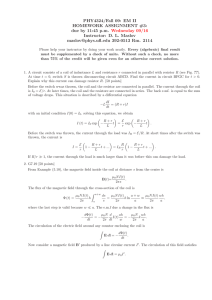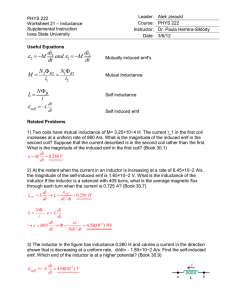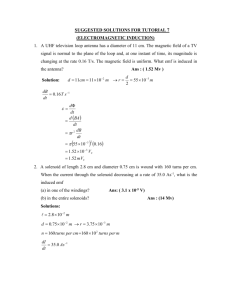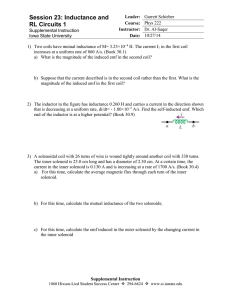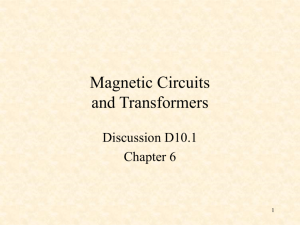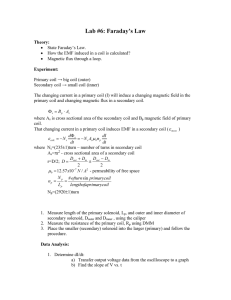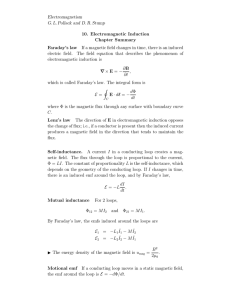Gauss`s law, electric flux, , Matlab electric fields and potentials
advertisement
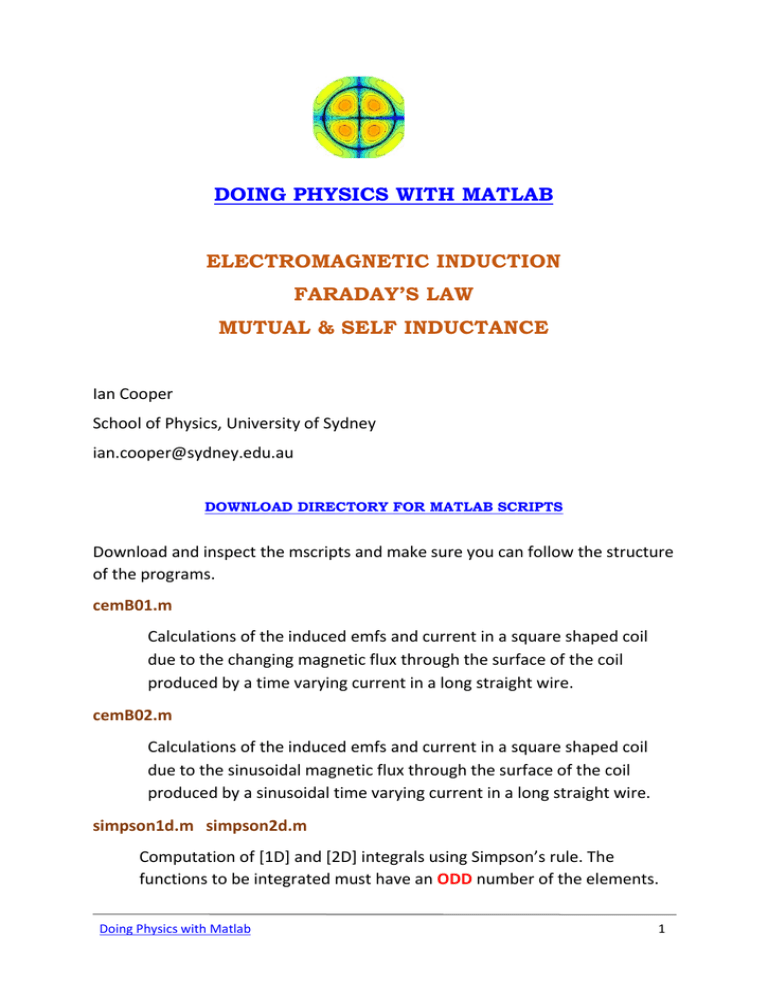
DOING PHYSICS WITH MATLAB ELECTROMAGNETIC INDUCTION FARADAY’S LAW MUTUAL & SELF INDUCTANCE Ian Cooper School of Physics, University of Sydney ian.cooper@sydney.edu.au DOWNLOAD DIRECTORY FOR MATLAB SCRIPTS Download and inspect the mscripts and make sure you can follow the structure of the programs. cemB01.m Calculations of the induced emfs and current in a square shaped coil due to the changing magnetic flux through the surface of the coil produced by a time varying current in a long straight wire. cemB02.m Calculations of the induced emfs and current in a square shaped coil due to the sinusoidal magnetic flux through the surface of the coil produced by a sinusoidal time varying current in a long straight wire. simpson1d.m simpson2d.m Computation of [1D] and [2D] integrals using Simpson’s rule. The functions to be integrated must have an ODD number of the elements. Doing Physics with Matlab 1 Faraday’s law is applied to a system of a long straight wire (1) and a square shaped conducting coil (2). A time dependent current I1 in the wire produces a time varying magnetic field B surrounding it. The coil is coupled to the wire by the mutual inductance M of the system of wire and coil. The changing magnetic flux B through the coil induces emf 1 around the coil which opposes the change in magnetic flux through it. The coil has a self-inductance L and the current in the coil produces its own emf 2 to oppose the emf 1 . Fig. 1. System of long straight wire conductor aligned along the Y axis and conducting square shaped coil aligned in the XY plane and centred on the X axis. The current in the wire is I1 and the induced current in the coil is I 2 . The side length of the square coil is s L and the radius of the coil wire is a. The closest side of the coil to the wire is the distance x1 and the opposite of the side of the coil is at a distance x2 x1 sL . The conductivity of the of the coil is (resistivity 1 / ) and the resistance of the coil is R. The magnetic field B through the coil is parallel to the Z axis and the magnetic flux through the coil is B . Doing Physics with Matlab 2 The magnitude of the magnetic field B at a distance x from the wire is (1) I B 0 1 2 x If the wire current I1 is in the +Y direction, the magnetic field is in the –Z direction through the coil and in the +Z direction if the wire current I1 is the –Y direction (right hand screw rule). The magnetic flux B through the square coil is sL /2 B B dA x s /2 B dy dx x2 (2) 1 A 0 2 B L x2 sL I1 log e x1 Faraday’s law can we expressed as (3) d B dt E ds E dB dt Normally we think of fields created by charges. However, when a magnetic flux through some surface changes with time, then there is also an electric field created to give an emf around the boundary of the surface. A steady current I1 in the wire produces a constant magnetic flux B through the coil and the induced emf is zero. Only when the wire current I1 changes with time that the magnetic flux B changes and a net emf created around the coil (the coil forms the boundary of the surface through which the magnetic flux changes). The induced emf drives a current I 2 through the conductive coil. The direction of the induced current I 2 in the coil is determined by Lenz’s law. The induced current I 2 gives a magnetic flux that opposes the change in magnetic flux B produced by the wire current I1 . Hence, the direction of the induced current I 2 can be determined by using the right hand screw rule. In figure 1, if the current I1 is increasing the magnetic field through the coil is increasing in the –Z direction. The induced current I 2 in the coil is in an anticlockwise sense which gives its magnetic field in the + Z direction (opposite to the B field from the wire). Doing Physics with Matlab 3 The magnetic flux B at every point within the coil is proportional to the wire current I1 (equation 2), therefore, we can write (4) B M I1 where the constant of proportionality M is the mutual inductance of the system composed of the coil and long straight wire. The S.I. unit for the mutual inductance is the henry [H]. From equations 1 and 2, the mutual inductance M is (5a) M 0 2 (5b) s x2 dx M 0 L 2 x1 x (5c) x s M 0 L log e 2 x2 sL /2 x1 sL /2 2 dy dx x x1 We have three ways of computing M. For the surface enclosed by the coil a [2D] grid can be created. Then M from equation 5a can be estimated by calling the function simpson2d.m which evaluates the integral for the grid of NxN points where N must be an odd number. The integral in equation 5b can be evaluated by dividing the area of the coil into strips parallel to the Y axis and using the function simpson1d.m. M can be found analytically using equation 5c. Matlab cemB01.m Setting up the [2D] grid % Grid for square coil xG x = linspace(x1,x2,N); y = linspace(y1,y2,N); [xG, yG] = meshgrid(x,y); Doing Physics with Matlab yG 4 Computing the mutual inductance % Mutual inductance for wire and square coil M: three ways of calculating fn = (1./xG); ax = x1; bx = x2; ay = y1; by = y2; integral2D = simpson2d(fn,ax,bx,ay,by); M1 = (mu0 / (2*pi)) * integral2D; fn = 1./x; integral1D = simpson1d(fn,ax,bx); M2 = (mu0 / (2*pi)) * (by-ay) * integral1D; M3 = (y2 - y1)* mu0/(2*pi) * log(x2/x1); M = M1; The three ways of computing M give the exact same result. The current I 2 in the coil also creates a magnetic field and a magnetic flux through the coil. If this current changes with time, so does the magnetic flux and additional emf exists around the coil. This additional emf influences the current I 2 . emf generated by current I1 in the wire (6) 1 M dI1 dt emf generated by current I 2 in the coil (7) 2 L dI 2 dt where L is the constant of proportionality called the self-inductance [henries H]. The self-inductance L for the square coil of side length sL and the coil wire has a circular cross-section with radius a, then (8) s L 8.0 10 7 sL log e L a 0.52401 where L is in henries, sL and a are in meters. Doing Physics with Matlab 5 So, the changing current I1 in the wire gives the time varying magnetic flux B through the coil that induces an electric field that produces an emf in the coil which drives the coil current I 2 . The emf around the coil is (9) 1 2 2 0 If the coil has a resistance R, then I 2 R and we can obtain a differential equation that can be solved to give the coil current I 2 dI1 dI L 2 dt dt (10) I2 R M (11) dI 2 M dI1 R I2 dt L dt L Analytical solution of equation 11 dI 2 M dI1 R I2 dt L dt L dI 2 k1 k 2 I 2 dt dI 2 dt k1 k 2 I 2 t 0 dt I2 0 M dI k1 1 L dt R k2 L dI 2 k1 k 2 I 2 1 I2 t log e k1 k 2 I 2 0 k2 k k I k 2 t log e 1 2 2 k1 k1 k 2 I 2 exp k 2 t k1 (12) k I 2 1 1 exp k2 t k2 Doing Physics with Matlab 6 Finite difference solution to equation 11 A finite difference method can be used to solve equation 11. This approach is better, because you can’t always find an analytical solution. The first derivative is approximated by the finite difference I n 1 I n dI dt t for time steps n 1 and n where n = 1, 2, 3, … , N (N odd integer) M R t I 2 n 1 I 2 n I1 n 1 I1 n I 2 n L L (13) Given the initial values (n = 1) of I1 and I 2 it is easy to find the values of I 2 at later times. Example 1 cemB01.m Wire current varies linearly with time I1 I10 t I10 2.0A dI1 = 2.0 A.s-1 dt constant (don’t need numerical approximation for derivative) Square coil side length sL = 1.0 m radius a = 1.0x10-3 m copper wire resistivity 1.68x10-8 .m resistance R = 0.0214 distance from wire x1 = 0.10 m self inductance L = 5.1070x10-6 H Wire and coil mutual inductance M = 4.7958x10-7 H Doing Physics with Matlab 7 Figure 2 show plots of the wire current I1 and the induced coil current I 2 . The current I 2 is computed by solving equation 11 and the numerical result is identical to the analytical solution provided the time step is smaller enough. The analytical solution gives a saturation value I 2 sat for the current I 2 as t (14) I 2 sat k1 M dI1 4.484 10 5 A k2 R dt Fig. 2. The time variation of the wire current I1 and induced coil current I 2 . The saturation current for the induced coil current is 4.484x10-5 A. From the solution given by equation 12, we can define a time constant such that k2 1 1 / k2 L / R 2.388 10 4 s I2 k1 1 e 1 0.6321 I 2 sat 2.834 10 5 A k2 The value for the time constant calculated numerically is the same as the analytical value for 5001 grid points and 5001 time steps ( t 1.00 106 s ). The final steady state value I 2 sat does not depend upon the self-inductance L, but the time the current takes to the reach steady state does. Doing Physics with Matlab 8 The self-inductance tends to inhibit changes in the coil current I 2 , and the larger the value of L, the longer the system takes to reach steady-state. The induced emf in the coil is due to two components: the mutual inductance of the wire and coil 1 and the self-inductance of the coil 2 as described by equations 6, 7, and 9. Figure 3 shows a plot of the emf induced in the coil. Fig. 3. net emf induced in the coil and its components 1 and 2 . 1sat 9.591 10 7 V 2 sat 0 V Can we find the electric field induced by the time varying magnetic flux? You may think that equation 3 can be used to find the value of E dB E ds dt dB E dt (3) but this can only be done for very symmetrical cases such as when there is circular symmetry. Consider an irregular shape closed loop. An emf is induced in the loop due to an induced electric field whose direction and magnitude at points around the loop vary quite differently. Faraday’s law does not allow us to find anything more than the average magnitude of the electric field, the direction and magnitude depend on the path chosen. The induced emf around Doing Physics with Matlab 9 a closed path has meaning whether or not a conductor lies on the path. The electric field is not directly related to the value of B at points on the path taken, it only depends on the rate of change of the magnetic flux within the area enclosed by the loop. We can find an average value for the electric field EavgL the current around the closed coil from the line integral form of Faraday’s law (15) d B dt EavgL E ds E avgL ds 4 s L EavgL 4 sL The numerical value of EavgL for the parameters of Example 1 when a steady state situation has been reached is EavgL 2.398 107 V.m-1 sat 9.592 107 V sL 1.0 m We can also find the value of the average electric field EavgJ from equation 16 (16) J E where the electric field E drives the current density J through a material with conductivity . EavgJ I 2 sat 2.398 10 7 V.m -1 2 a I 2 sat 4.708 10 5 A a 1.000 10 3 m for copper Doing Physics with Matlab 1 1.68 10 8 Ω.m 10 Changing input parameters L 2 L 1.021 10 5 H ( L) 2.388 104 s (2 L) 4.775 10 4 s The only change is that it takes longer to reach the steady state situation R 2 R 0.043 ( R ) 2.388 10 4 s (2 R ) 1.194 10 4 s I 2 sat ( R ) 4.484 10 5 A I 2 sat (2 R ) 2.242 10 5 A No change in emfs x1 x1 / 2 0.05 m M ( x1 ) 4.796 10 7 H M ( x1 / 2) 6.089 10 7 H I 2 sat ( x1 ) 4.484 10 5 A I 2 sat ( x1 / 2) 5.693 10 5 A emf sat ( x1 ) 9.591 10 7 V emf sat ( x1 / 2) 12.18 10 7 A No change in time constant Reducing the area of the coil, reduces the magnetic flux and hence reduces the magnitude of the current induced in the coil. Doing Physics with Matlab 11 Example 2: Sinusoidal variation in magnetic flux cemB02.m The induced current I 2 in the square shaped coil is produced by a time varying sinusoidal current I1 in the long straight wire. You can vary the frequency f of the sinusoidal current I1 in the wire to investigate how the induced current I 2 depends upon the frequency f of the changing magnetic flux through the coil. wire I1: frequency f = 50.0 Hz coil: max current I2 = 63.22 mA coil: max emf = 1.35 mV coil: max emf1 = 1.36 mV coil: max emf2 = 0.10 mV Doing Physics with Matlab 12 wire I1: frequency f = 200.0 Hz coil: max current I2 = 243.00 mA coil: max emf = 5.19 mV coil: max emf1 = 5.42 mV coil: max emf2 = 1.56 mV Doing Physics with Matlab 13 wire I1: frequency f = 1000.0 Hz coil: max current I2 = 703.84 mA coil: max emf = 15.01 mV coil: max emf1 = 27.12 mV coil: max emf2 = 22.58 mV As expected, the greater the frequency (the greater the rate of change in the magnetic flux and the larger the induced currents in the copper coil. Doing Physics with Matlab 14
